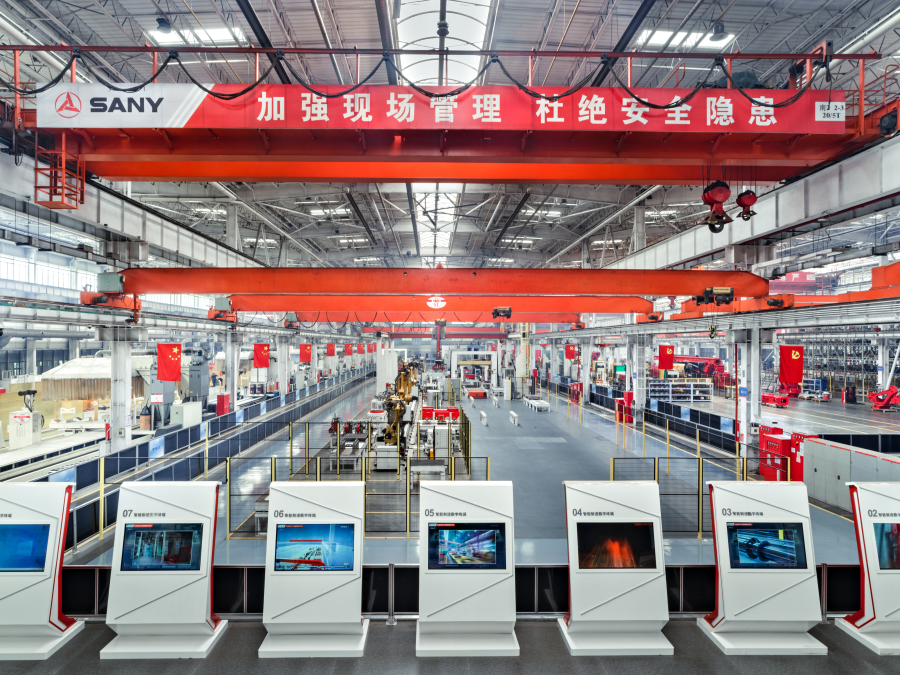"Lighthouse factory" leads the way in China's smart manufacturing

Photo taken on Oct. 15, 2021 shows the workshop No.1 of the Sany Group's Beijing Rotary Drilling Rig Plant. (Sany Group/Handout via Xinhua)
BEIJING, Oct. 20 (Xinhua) -- Few operators are needed at the Sany Group's Beijing Rotary Drilling Rig Plant, as industrial robots are the leading employees when it comes to assembling machinery.
The smart factory, located in Changping District of the Chinese capital, was in September added to the World Economic Forum's Global Lighthouse Network, which recognizes factories showing leadership in the Fourth Industrial Revolution.
Notably, the factory in Beijing is the first heavy industry enterprise to be added to the list globally.
With a workshop area of four hectares, the futuristic plant is well equipped with 12 automated production lines and 150 robots.
Human workers have also been trained as technicians who can operate the robots directly, according to Dong Mingkai, dean of Sany's intelligent manufacturing research institute.
The factory has deployed a new manufacturing model with advanced human-machine collaboration automation, artificial intelligence and Internet of Things technologies.
The upgrade has served as a boost for production efficiency and product quality, as these innovations have managed to increase labor productivity by 85 percent and slash production lead time by 77 percent, accelerating from almost a month to just a week.
On the automatic assembly line for small and medium-sized parts, Automatic Guided Vehicle (AGV) and industrial robots connected to the 5G network can move freely on the ground. Together with truss manipulators, the devices are able to position, grasp and assemble machinery parts in an orderly manner.
Nearly 30 model varieties can be produced with the help of robots and core intelligent technologies including laser and visual sensing, working to meet the growing demand for multi-category and small-batch flexible assembly and take a lead in the whole industry, according to Dong.
The factory's number of human workers has decreased from 2,000 to just a fifth of that, while the annual volume of equipment produced has soared from 1,000 to 3,000 units, said Dai Qinghua, director of the Sany Group.
As China promotes green and low-carbon development, and promises to peak carbon emissions before 2030 and achieve carbon neutrality before 2060, the country has reached a consensus to promote a more eco-friendly engineering machinery industry.
The "lighthouse factories" represented by Sany Group's Beijing Rotary Drilling Rig Plant are just one example of Chinese enterprises' unremitting pursuit of high-quality and low-carbon development through digital transformations.
"The plant is resource-saving and eco-friendly, and its demand for and consumption of electricity are obviously decreasing," said Tang Xiuguo, president of Sany Group. He said the power generated by the group's self-sustaining wind power plant has far exceeded the power consumption of all its factories.
"Sany Group will actively explore the applications of new energy to save energy and improve energy efficiency. And existing construction machinery products built with diesel engines and petrochemical energy are expected to rely on electricity in the future," Dai said.
Photos
Related Stories
- Chinese researchers develop 4D-printed soft robot with tactile perception
- Panda Robot for China Pavilion at Expo 2020 Dubai makes global debut
- China makes great strides in robot industry
- Greece's Hellenic Post employs Chinese-made mail sorting robots
- China’s booming robot industry displays a wider range of innovations and applications
Copyright © 2021 People's Daily Online. All Rights Reserved.










